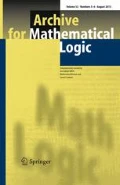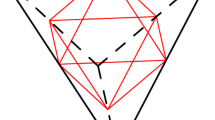Abstract
The classical Hahn–Banach Theorem states that any linear bounded functional defined on a linear subspace of a normed space admits a norm-preserving linear bounded extension to the whole space. The constructive and computational content of this theorem has been studied by Bishop, Bridges, Metakides, Nerode, Shore, Kalantari Downey, Ishihara and others and it is known that the theorem does not admit a general computable version. We prove a new computable version of this theorem without unrolling the classical proof of the theorem itself. More precisely, we study computability properties of the uniform extension operator which maps each functional and subspace to the set of corresponding extensions. It turns out that this operator is upper semi-computable in a well-defined sense. By applying a computable version of the Banach–Alaoglu Theorem we can show that computing a Hahn–Banach extension cannot be harder than finding a zero in a compact metric space. This allows us to conclude that the Hahn–Banach extension operator is \({\bf {\Sigma^{0}_{2}}}\) -computable while it is easy to see that it is not lower semi-computable in general. Moreover, we can derive computable versions of the Hahn–Banach Theorem for those functionals and subspaces which admit unique extensions.
Similar content being viewed by others
References
Banach S. (1929). Sur les fonctionnelles linéaires I. Stud. Math. 1: 211–216
Banach S. and Mazur S. (1937). Sur les fonctions calculables. Ann. Soc. Pol. Math. 16: 223
Bishop E. and Bridges D.S. (1985). Constructive Analysis, Grundlehren der Mathematischen Wissenschaften, Vol. 279. Springer, Berlin
Brattka, V.: Computability of Banach space principles. Informatik Berichte 286, FernUniversität Hagen, Fachbereich Informatik, Hagen (2001)
Brattka V. (2003). Computability over topological structures. In: Cooper, S.B. and Goncharov, S.S. (eds) Computability and Models, pp 93–136. Kluwer, New York
Brattka V. (2003). The inversion problem for computable linear operators. In: Alt, H. and Habib, M. (eds) STACS 2003. Lecture Notes in Computer Science, Vol. 2607, pp 391–402. Springer, Berlin
Brattka, V.: On the Borel complexity of Hahn-Banach extensions. In: Brattka, V., Staiger, L., Weihrauch, K. (eds.) Computability and Complexity in Analysis, Informatik Berichte, Vol. 320, pp. 1–13. FernUniversität in Hagen (2004)
Brattka V. (2005). Computability on non-separable Banach spaces and Landau’s theorem. In: Crosilla, L. and Schuster, P. (eds) From Sets and Types to Topology and Analysis: Towards Practicable Foundations for Constructive Mathematics., pp 316–333. Oxford University Press, Oxford
Brattka V. (2005). Effective Borel measurability and reducibility of functions. Math. Logic Q. 51(1): 19–44
Brattka, V.: Computable versions of the uniform boundedness theorem. In: Chatzidakis, Z., Koepke, P., Pohlers, W. (eds.) Logic Colloquium 2002, Lecture Notes in Logic, Vol. 27. Association for Symbolic Logic, Urbana (2006)
Brattka V. and Presser G. (2003). Computability on subsets of metric spaces. Theor. Comput. Sci. 305: 43–76
Bridges D. and Richman F. (1987). Varieties of constructive mathematics, London Mathematical Society Lecture Note Series, Vol. 97. Cambridge University Press, Cambridge
Downey R. and Kalantari I. (1985). Effective extensions of linear forms on a recursive vector space over a recursive field. Zeitschrift für Mathematische Logik und Grundlagen der Mathematik 31(3): 193–200
Engelking R. (1989). General topology, Sigma series in pure mathematics, Vol. 6. Heldermann, Berlin
Foguel S.R. (1958). On a Theorem by A.E. Taylor. Proc. Am. Math. Soc. 9: 325
Goffman C. and Pedrick G. (1965). First course in functional analysis. Prentince-Hall, Englewood Cliffs
Grzegorczyk A. (1957). On the definitions of computable real continuous functions. Fundam. Math. 44: 61–71
Hahn H. (1927). Über lineare Gleichungssysteme in linearen Räumen. J. für reine Angew. Math. 157: 214–229
Ishihara H. (1989). On the constructive Hahn-Banach theorem. Bull. Lond. Math. Soc. 21(1): 79–81
Ishihara H. (1990). An omniscience principle, the König lemma and the Hahn–Banach Theorem. Zeitschrift für Mathematische Logik und Grundlagen der Mathematik 36: 237–240
Ko K.I. (1991). Complexity theory of real functions. Progress in theoretical computer science. Birkhäuser, Boston
Lacombe, D.: Extension de la notion de fonction récursive aux fonctions d’une ou plusieurs variables réelles I–III. C. R. Acad. Sci. Paris 240, 241, 2478–2480, 13–14, 151–153 (1955)
Metakides G. and Nerode A. (1982). The introduction of non-recursive methods into mathematics. In: Troelstra, A. and Dalen, D.v. (eds) The L.E.J. Brouwer Centenary Symposium, Studies in Logic and the Foundations of Mathematics, Vol. 110, pp 319–335. Amsterdam, North-Holland
Metakides G., Nerode A. and Shore R. (1985). Recursive limits on the Hahn–Banach theorem. In: Rosenblatt, M. (eds) Errett Bishop: Reflections on Him and His Research, Contemporary Mathematics, Vol. 39, pp 85–91. American Mathematical Society, Providence
Phelps R.R. (1989). Convex Functions, Monotone Operators and Differentiability, Lecture Notes in Mathematics, Vol. 1364. Springer, Berlin
Pour-El M.B. and Richards J.I. (1989). Computability in Analysis and Physics. Perspectives in Mathematical Logic. Springer, Berlin
Schechter E. (1997). Handbook of Analysis and Its Foundations. Academic, San Diego
Simpson S.G. (1999). Subsystems of Second Order Arithmetic. Perspectives in Mathematical Logic. Springer, Berlin
Sims B. and Yost D. (1989). Linear Hahn–Banach extension operators. Proc. Edinburgh Math. Soc. 32: 53–57
Taylor A.E. (1939). The extension of linear functionals. Duke Math. J. 5: 538–547
Turing A.M. (1936). On computable numbers, with an application to the “Entscheidungsproblem”. Proc. Lond. Math. Soc. 42(2): 230–265
Weihrauch K. (2000). Computable Analysis. Springer, Berlin
Weihrauch K. (2001). On computable metric spaces Tietze–Urysohn extension is computable. In: Blanck, J., Brattka, V. and Hertling, P. (eds) Computability and Complexity in Analysis, Lecture Notes in Computer Science, Vol. 2064, pp 357–368. Springer, Berlin
Author information
Authors and Affiliations
Corresponding author
Additional information
This work has been partially supported by the National Research Foundation (NRF) Grant FA2005033000027 on “Computable Analysis and Quantum Computing”. An extended abstract version has been published in the conference proceedings [7].
Rights and permissions
About this article
Cite this article
Brattka, V. Borel complexity and computability of the Hahn–Banach Theorem. Arch. Math. Logic 46, 547–564 (2008). https://doi.org/10.1007/s00153-007-0057-z
Received:
Published:
Issue Date:
DOI: https://doi.org/10.1007/s00153-007-0057-z




